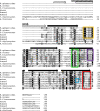TSPO protein binding partners in bacteria, animals, and plants
- PMID: 34191248
- PMCID: PMC8243069
- DOI: 10.1007/s10863-021-09905-4
TSPO protein binding partners in bacteria, animals, and plants
Abstract
The ancient membrane protein TSPO is phylogenetically widespread from archaea and bacteria to insects, vertebrates, plants, and fungi. TSPO's primary amino acid sequence is only modestly conserved between diverse species, although its five transmembrane helical structure appears mainly conserved. Its cellular location and orientation in membranes have been reported to vary between species and tissues, with implications for potential diverse binding partners and function. Most TSPO functions relate to stress-induced changes in metabolism, but in many cases it is unclear how TSPO itself functions-whether as a receptor, a sensor, a transporter, or a translocator. Much evidence suggests that TSPO acts indirectly by association with various protein binding partners or with endogenous or exogenous ligands. In this review, we focus on proteins that have most commonly been invoked as TSPO binding partners. We suggest that TSPO was originally a bacterial receptor/stress sensor associated with porphyrin binding as its most ancestral function and that it later developed additional stress-related roles in eukaryotes as its ability to bind new partners evolved.
Keywords: 14-3-3 proteins; Autophagy; NADPH oxidase; Protein–protein interactions; TSPO; VDAC.
© 2021. The Author(s).
Conflict of interest statement
Not applicable.
Figures



References
-
- Aghazadeh Y, Rone MB, Blonder J, Ye X, Veenstra TD, Hales DB, Culty M, Papadopoulos V. Hormone-induced 14-3-3gamma adaptor protein regulates steroidogenic acute regulatory protein activity and steroid biosynthesis in MA-10 Leydig cells. J Biol Chem. 2012;287(19):15380–15394. doi: 10.1074/jbc.M112.339580. - DOI - PMC - PubMed
Publication types
MeSH terms
Substances
Grants and funding
LinkOut - more resources
Full Text Sources

